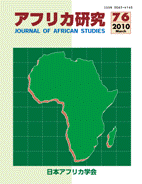Volume 2012, Issue 81
Displaying 1-9 of 9 articles from this issue
- |<
- <
- 1
- >
- >|
Articles
-
Article type: Articles
2012 Volume 2012 Issue 81 Pages 1-15
Published: December 31, 2012
Released on J-STAGE: March 28, 2014
Download PDF (2625K) -
Article type: Articles
2012 Volume 2012 Issue 81 Pages 17-30
Published: December 31, 2012
Released on J-STAGE: March 28, 2014
Download PDF (2892K)
Note
-
Article type: Note
2012 Volume 2012 Issue 81 Pages 31-44
Published: December 31, 2012
Released on J-STAGE: March 28, 2014
Download PDF (2144K)
Reports
-
Article type: Reports
2012 Volume 2012 Issue 81 Pages 45-59
Published: May 31, 2012
Released on J-STAGE: March 28, 2014
Download PDF (3119K)
Book Reviews
-
Article type: Book Review
2012 Volume 2012 Issue 81 Pages 61-63
Published: May 31, 2012
Released on J-STAGE: March 28, 2014
Download PDF (1650K) -
Article type: Book Review
2012 Volume 2012 Issue 81 Pages 63-67
Published: May 31, 2012
Released on J-STAGE: March 28, 2014
Download PDF (1672K) -
Article type: Book Review
2012 Volume 2012 Issue 81 Pages 67-69
Published: May 31, 2012
Released on J-STAGE: March 28, 2014
Download PDF (1651K) -
Article type: Book Review
2012 Volume 2012 Issue 81 Pages 69-72
Published: May 31, 2012
Released on J-STAGE: March 28, 2014
Download PDF (1618K)
Book Information
-
Article type: Book Information
2012 Volume 2012 Issue 81 Pages 73-74
Published: May 31, 2012
Released on J-STAGE: March 28, 2014
Download PDF (1429K)
- |<
- <
- 1
- >
- >|
